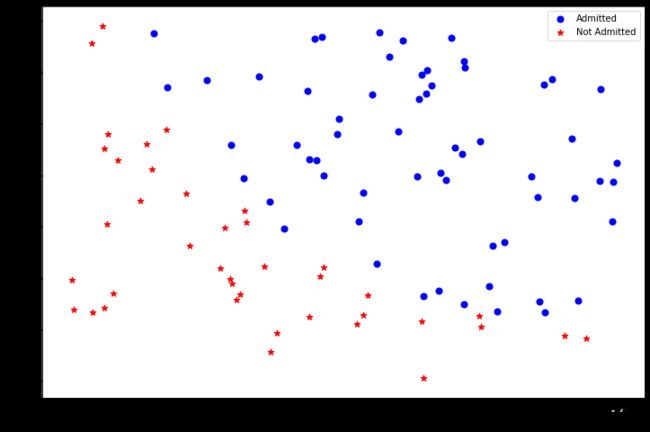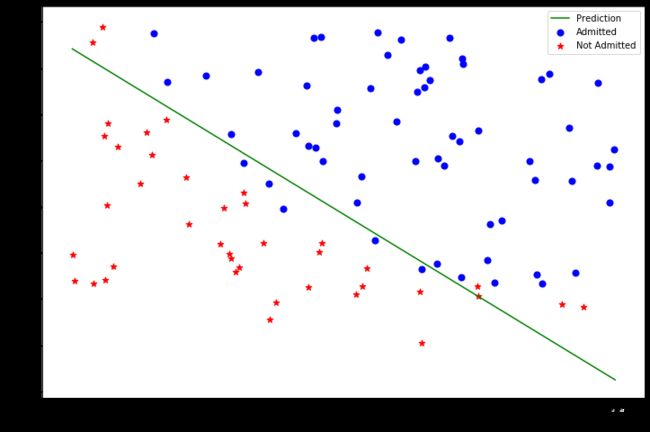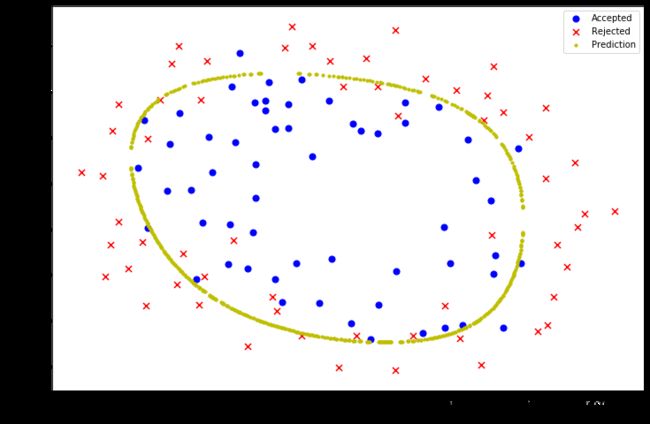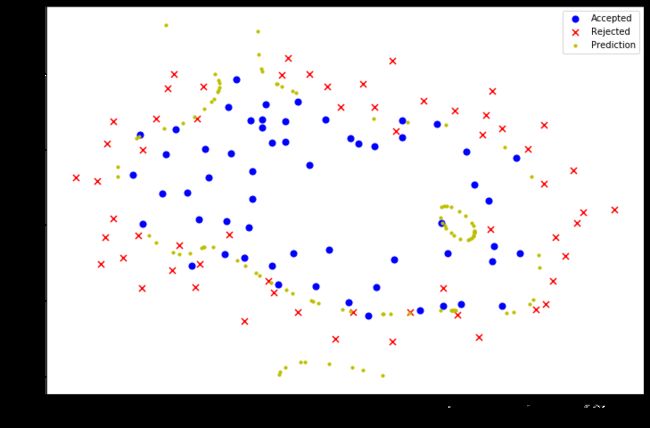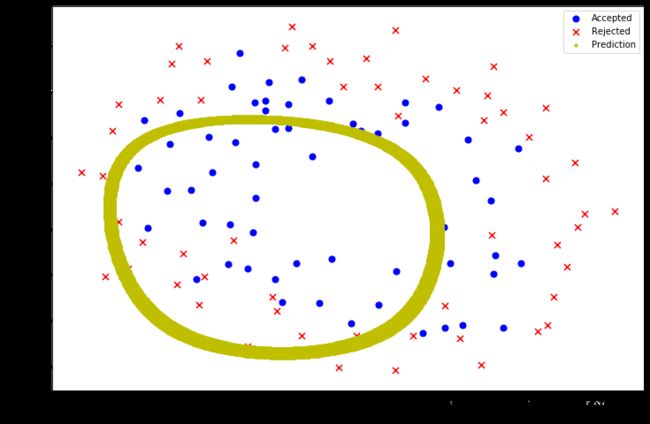吴恩达机器学习课程ex2 Python实现
逻辑回归
在训练的初始阶段,我们将要构建一个逻辑回归模型来预测,某个学生是否被大学录取。
设想你是大学相关部分的管理者,想通过申请学生两次测试的评分,来决定他们是否被录取。
现在你拥有之前申请学生的可以用于训练逻辑回归的训练样本集。对于每一个训练样本,你有他们两次测试的评分和最后是被录取的结果
数据可视化
import numpy as np
import pandas as pd
import matplotlib.pyplot as plt
#读取数据
path = 'ex2data1.txt'
data = pd.read_csv(path,header = None, names=['Exam1','Exam2','Admitted'])
data.head()
| Exam1 | Exam2 | Admitted | |
|---|---|---|---|
| 0 | 34.623660 | 78.024693 | 0 |
| 1 | 30.286711 | 43.894998 | 0 |
| 2 | 35.847409 | 72.902198 | 0 |
| 3 | 60.182599 | 86.308552 | 1 |
| 4 | 79.032736 | 75.344376 | 1 |
#可视化
positive = data[data['Admitted']==1]
negative = data[data['Admitted']==0]
fig,ax = plt.subplots(figsize=(12,8))
ax.scatter(positive['Exam1'],positive['Exam2'],s=50,c='b',marker = 'o',label='Admitted')
ax.scatter(negative['Exam1'],negative['Exam2'],s=50,c='r',marker = '*',label='Not Admitted')
ax.legend()
ax.set_xlabel('Exam1 Score')
ax.set_ylabel('Exam2 Score')
plt.show()
逻辑回归实现
sigmoid函数
def sigmoid(z):
return 1/(1+np.exp(-z))
代价函数和梯度
def cost(theta,X,y):
theta = np.matrix(theta)
X = np.matrix(X)
y = np.matrix(y)
left = np.multiply(-y,np.log(sigmoid(X*theta.T)))
right = np.multiply((1-y),np.log(1-sigmoid(X*theta.T)))
return np.sum(left-right)/(len(X))
# 初始化X,y,theta
data.insert(0,'Ones',1)
cols = data.shape[1]
X = data.iloc[:,:cols-1]
y = data.iloc[:,cols-1:cols]
theta = np.zeros(3)
X = np.array(X.values)
y = np.array(y.values)
#确认三个矩阵的维度
X.shape,y.shape,theta.shape
((100, 3), (100, 1), (3,))
cost(theta,X,y)
0.6931471805599453
#实现梯度计算但是不更新theta
def gradient(theta,X,y):
theta = np.matrix(theta)
X = np.matrix(X)
y = np.matrix(y)
parameters = int(theta.ravel().shape[1])
grad = np.zeros(parameters)
error = sigmoid(X*theta.T) - y
for i in range(parameters):
grad[i] = np.sum(np.multiply(X[:,i],error))/len(X)
return grad
用工具库计算 θ \theta θ
在此前的线性回归中,我们自己写代码实现的梯度下降(ex1的2.2.4的部分)。当时我们写了一个代价函数、计算了他的梯度,然后对他执行了梯度下降的步骤。这次,我们不自己写代码实现梯度下降,我们会调用一个已有的库。这就是说,我们不用自己定义迭代次数和步长,功能会直接告诉我们最优解。
andrew ng在课程中用的是Octave的“fminunc”函数,由于我们使用Python,我们可以用scipy.optimize.fmin_tnc做同样的事情。
import scipy.optimize as opt
result = opt.fmin_tnc(func=cost,x0=theta,fprime = gradient,args=(X,y))
result
(array([-25.16131863, 0.20623159, 0.20147149]), 36, 0)
p.s.
fmin_tnc()
有约束的多元函数问题,提供梯度信息,使用截断牛顿法。
调用:
scipy.optimize.fmin_tnc(func, x0, fprime=None, args=(), approx_grad=0, bounds=None, epsilon=1e-08, scale=None, offset=None, messages=15, maxCGit=-1, maxfun=None, eta=-1, stepmx=0, accuracy=0, fmin=0, ftol=-1, xtol=-1, pgtol=-1, rescale=-1, disp=None, callback=None)
最常使用的参数:
func:优化的目标函数
x0:初值
fprime:提供优化函数func的梯度函数,不然优化函数func必须返回函数值和梯度,或者设置approx_grad=True
approx_grad :如果设置为True,会给出近似梯度
args:元组,是传递给优化函数的参数
返回:
x : 数组,返回的优化问题目标值
nfeval : 整数,function evaluations的数目
在进行优化的时候,每当目标优化函数被调用一次,就算一个function evaluation。在一次迭代过程中会有多次function evaluation。这个参数不等同于迭代次数,而往往大于迭代次数。
rc : int,Return code, see below
#用算法得出的theta值计算cost值
cost(result[0],X,y)
0.20349770158947458
plotting_x1 = np.linspace(30,100,100)
plotting_exam2_predicted = (-result[0][0]-result[0][1]*plotting_x1)/result[0][2]
fig,ax = plt.subplots(figsize=(12,8))
ax.plot(plotting_x1,plotting_exam2_predicted,'g',label='Prediction')
ax.scatter(positive['Exam1'],positive['Exam2'],s=50,c='b',marker = 'o',label='Admitted')
ax.scatter(negative['Exam1'],negative['Exam2'],s=50,c='r',marker = '*',label='Not Admitted')
ax.legend()
ax.set_xlabel('Exam1 Score')
ax.set_ylabel('Exam2 Score')
plt.show()
评价逻辑回归模型
在确定参数之后,我们可以使用这个模型来预测学生是否录取。如果一个学生exam1得分45,exam2得分85,那么他录取的概率应为0.776。另一种评价θ的方法是看模型在训练集上的正确率怎样。写一个predict的函数,给出数据以及参数后,会返回“1”或者“0”。然后再把这个predict函数用于训练集上,看准确率怎样。
#实现htheta
def hfunc1(theta, X):
return sigmoid(np.dot(theta.T, X))
hfunc1(result[0],[1,45,85])
0.7762906238162848
#定义predict函数
def predict(theta,X):
probability = sigmoid(X*theta.T)
return[1 if x > 0.5 else 0 for x in probability]
#统计正确率
theta_min = np.matrix(result[0])
predictions = predict(theta_min,X)
correct = [1 if (a==1 and b==1) or (a==0 and b==0) else 0 for (a,b)in zip(predictions,y)]
accuracy = (sum(correct))%len(correct)
print ('accuracy = {0}%'.format(accuracy))
accuracy = 89%
正则化逻辑回归
在训练的第二部分,我们将实现加入正则项提升逻辑回归算法。
设想你是工厂的生产主管,你有一些芯片在两次测试中的测试结果,测试结果决定是否芯片要被接受或抛弃。你有一些历史数据,帮助你构建一个逻辑回归模型。
数据可视化
path = 'ex2data2.txt'
data_init = pd.read_csv(path,header = None,names=['Test1','Test2','Accepted'])
data_init.head()
| Test1 | Test2 | Accepted | |
|---|---|---|---|
| 0 | 0.051267 | 0.69956 | 1 |
| 1 | -0.092742 | 0.68494 | 1 |
| 2 | -0.213710 | 0.69225 | 1 |
| 3 | -0.375000 | 0.50219 | 1 |
| 4 | -0.513250 | 0.46564 | 1 |
positive2 = data_init[data_init.Accepted==1]
negative2 = data_init[data_init.Accepted==0]
fig,ax = plt.subplots(figsize=(12,8))
ax.scatter(positive2.Test1,positive2.Test2,c='b',marker = 'o',label='Test1')
ax.scatter(negative2.Test1,negative2.Test2,c='r',marker = 'x',label='Test2')
ax.legend()
ax.set_xlabel('Test1')
ax.set_ylabel('Test2')
plt.show()
不适用于线性切割,所以不能直接使用逻辑回归
特征映射
一种更好的使用数据集的方式是为每组数据创造更多的特征。所以我们为每组添加了最高到6次幂的特征
degree = 6
data2 = data_init
#x1 = data2['Test1']
#x2 = data2['Test2']
#data2.insert(3,'Ones',1)
for i in range(1,degree+1):
for j in range(0,i+1):
data2['F'+str(i-j)+str(j)] = np.power(x1,i-j)*np.power(x2,j)
#data2.drop('Test1',axis=1,inplace = True)
#data2.drop('Test2',axis=1,inplace = True)
data2.shape
(118, 29)
代价函数和梯度
在普通的梯度计算中加入惩罚项
#实现正则化的代价函数
def costReg(theta,X,y,learningRate):
theta = np.matrix(theta)
X = np.matrix(X)
y = np.matrix(y)
left = np.multiply(-y,np.log(sigmoid(X*theta.T)))
right = np.multiply(1-y,np.log(1-sigmoid(X*theta.T)))
reg = (learningRate/(2*len(X)))*np.sum(np.power(theta[:,1:theta.shape[1]],2))
return np.sum(left-right)/len(X) + reg
#实现正则化的梯度函数
def gradientReg(theta,X,y,learningRate):
theta = np.matrix(theta)
X = np.matrix(X)
y = np.matrix(y)
parameters = int(theta.ravel().shape[1])
grad = np.zeros(parameters)
error = sigmoid(X*theta.T) - y
for i in range(parameters):
term = np.multiply(error,X[:,i])
if(i==0):
grad[i] = np.sum(term)/len(X)
else:
grad[i] = (np.sum(term)/len(X) + (learningRate/len(X))*theta[:,i])
return grad
#初始化X,y,theta
cols = data2.shape[1]
X2 = data2.iloc[:,1:cols]
y2 = data2.iloc[:,0:1]
theta2 = np.zeros(cols-1)
#类型转换
X2 = np.matrix(X2.values)
y2 = np.matrix(y2.values)
learningRate = 1
#计算初始代价
costReg(theta2,X2,y2,learningRate)
0.6931471805599454
#用工具库求解参数
result2 = opt.fmin_tnc(func = costReg,x0 = theta2,fprime = gradientReg,args=(X2,y2,learningRate))
result2
(array([ 1.27271026, 0.62529965, 1.18111686, -2.01987399, -0.91743189,
-1.43166929, 0.12393227, -0.36553118, -0.35725404, -0.17516291,
-1.45817009, -0.05098418, -0.61558554, -0.27469165, -1.19271298,
-0.2421784 , -0.20603299, -0.04466178, -0.2777895 , -0.29539513,
-0.45645982, -1.04319155, 0.02779373, -0.2924487 , 0.0155576 ,
-0.32742405, -0.1438915 , -0.92467487]), 32, 1)
theta_min = np.matrix(result2[0])
predictions = predict(theta_min,X2)
correct = [1 if ((a == 1 and b == 1) or (a == 0 and b == 0)) else 0 for (a, b) in zip(predictions, y2)]
accuracy = (sum(map(int, correct)) / len(correct))*100
print ('accuracy = {0}%'.format(accuracy))
accuracy = 83.05084745762711%
画出决策曲线
degree = 6
def hfunc2(theta,x1,x2):
temp = theta[0][0]
place = 0
for i in range(1,degree+1):
for j in range(0,i+1):
temp += np.power(x1,i-j)*np.power(x2,j)*theta[0][place+1]
place +=1
return temp
def find_decision_boundary(theta):
t1 = np.linspace(-1,1.5,1000)
t2 = np.linspace(-1,1.5,1000)
cordinates = [(x,y) for x in t1 for y in t2]
x_cord,y_cord = zip(*cordinates)
h_val = pd.DataFrame({'x1':x_cord,'x2':y_cord})
h_val['hval'] = hfunc2(theta,h_val['x1'],h_val['x2'])
decision = h_val[np.abs(h_val['hval'])<2*10**-3]
return decision.x1,decision.x2
fig, ax = plt.subplots(figsize=(12,8))
ax.scatter(positive2['Test1'], positive2['Test2'], s=50, c='b', marker='o', label='Accepted')
ax.scatter(negative2['Test1'], negative2['Test2'], s=50, c='r', marker='x', label='Rejected')
ax.set_xlabel('Test 1 Score')
ax.set_ylabel('Test 2 Score')
x, y = find_decision_boundary(result2)
plt.scatter(x, y, c='y', s=10, label='Prediction')
ax.legend()
plt.show()
#当lambda=0时过拟合
learningRate2 = 0
result3 = opt.fmin_tnc(func=costReg,x0=theta2,fprime=gradientReg,args=(X2,y2,learningRate2))
fig, ax = plt.subplots(figsize=(12,8))
ax.scatter(positive2['Test1'], positive2['Test2'], s=50, c='b', marker='o', label='Accepted')
ax.scatter(negative2['Test1'], negative2['Test2'], s=50, c='r', marker='x', label='Rejected')
ax.set_xlabel('Test 1 Score')
ax.set_ylabel('Test 2 Score')
x, y = find_decision_boundary(result3)
plt.scatter(x, y, c='y', s=10, label='Prediction')
ax.legend()
plt.show()
#当lambda=1000时欠拟合
learningRate3 = 100
result4 = opt.fmin_tnc(func=costReg, x0=theta2, fprime=gradientReg, args=(X2, y2, learningRate3))
fig, ax = plt.subplots(figsize=(12,8))
ax.scatter(positive2['Test1'], positive2['Test2'], s=50, c='b', marker='o', label='Accepted')
ax.scatter(negative2['Test1'], negative2['Test2'], s=50, c='r', marker='x', label='Rejected')
ax.set_xlabel('Test 1 Score')
ax.set_ylabel('Test 2 Score')
x, y = find_decision_boundary(result4)
plt.scatter(x, y, c='y', s=10, label='Prediction')
ax.legend()
plt.show()
